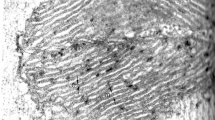Abstract
A method for measuring the net acid base exchange in an isolated rat diaphragm preparation is described. Particular attention is paid to monitoring the functional status and maintaining optimal diffusion conditions. A steady net acid efflux of the order of 250 n mole/g·min is found in the resting state. This increases following a series of isometric contractions. In the resting state the total measured lactate + pyruvate efflux was found to be less than the net acid efflux. The net acid efflux increases following a sudden decrease inpCO2 and decreases or reverses following a sudden increase inpCO2 or a decrease in external bicarbonate. The net base loss during a period of 1 h following the exposure to high (20%) CO2 represents a large fraction of the predicted total bicarbonate generated within the fibres by non-bicarbonate buffers. This indicates that the effects of intracellular non-bicarbonate buffers can be transmitted to the external solution following a change inpCO2. The most plausible explanation is that passive bicarbonate ion movements are responsible. Values of the ‘apparent\(P_{{\text{HCO}}_{\text{3}} }\)’ have been calculated and vary under different conditions from a value of 1.3×10−7 to 1.9×10−6 cm·s−1.
Similar content being viewed by others
References
Aickin, C. C., Thomas, R. C.: Microelectrode measurement of the intracellular pH and buffering power of mouse soleus muscle fibres. J. Physiol. (Lond.)267, 791–810 (1977)
Bettice, J. A., Wang, B. C., Brown, E. B.: Intracellular buffering of heart and skeletal muscles during the onset of hypercapnia. Respir. Physiol.28, 89–98 (1976)
Boron, W. F., De Weer, P.: Intracellular pH transients in Squid Giant Axons Caused by CO2, NH3, and Metabolic inhibitors. J. Gen. Physiol.67, 91–112 (1976)
Cechetto, D., Mainwood, G. W.: Acid-base exchange in the isolated rat diaphragm. J. Physiol. (Lond.)272, 55–56P (1977)
Giebisch, G., Berger, R., Pitts, R. F.: The extrarenal response to acute acid-base disturbances of respiratory origin. J. Clin. Invest.34, 231–245 (1955)
Heisler, N.: Intracellular pH of isolated rat diaphragm muscle with metabolic and respiratory changes of extracellular pH. Respir. Physiol.23, 242–255 (1975)
Heisler, N., Piiper, J.: The buffer value of rat diaphragm muscle tissue determined by PCO2 equilibration of homogenates. Respir. Physiol.12, 169–178 (1971)
Heisler, N., Weitz, H., Rother, K. F.: Efflux kinetics of hydrogen and lactate ions from isolated rat diaphragm. Proc. XXVII Int. Cong. Physiol. Sci.13, 315 Abst. 923 (1977)
Hollanders, F. D.: The production of lactic acid by the perfused rat diaphragm. Comp. Biochem. Physiol.26, 907–916 (1968)
Isutzu, K. T.: Intracellular pH, Hion flux and Hion permeability coefficient in bullfrog toe muscle. J. Physiol. (Lond.)221, 15–27 (1972)
Lai, Y. L., Martin, E. D., Atterbery, B. A., Brown, E. B.: Mechanisms of extracellular pH adjustments in hypercapnia. Respir. Physiol.19, 107–114 (1973a)
Lai, Y. L., Atterbery, B. A., Brown, E. B.: Intracellular adjustments of skeletal muscle, heart and brain to prolonged hypercapnia. Respir. Physiol.19, 115–122 (1973b)
Lai, Y. L., Atterbery, B. A., Brown, E. B.: Mechanisms of cardiac muscle adjustment to hypercapnia. Respir. Physiol.19, 123–129 (1973c)
Lucier, G. E., Mainwood, G. W.: The measurement of potassium efflux in superfused frog sartorius muscles. Can. J. Physiol. Pharmacol.50, 123–131 (1972)
Mainwood, G. W.: Some electrical characteristics of sucrose-washed frog sartorius muscle. Can. J. Physiol. Pharmacol.44, 663–674 (1966)
Mainwood, G. W., Worsley-Brown, P.: The effects of extracellular pH and buffer concentration on the efflux of lactate from frog sartorius muscle. J. Physiol. (Lond.)250, 1–22 (1975)
Roos, A.: Intracellular pH and distribution of weak acids across cell membranes. A study ofD- andL-lactate and of DMO in rat diaphragm. J. Physiol. (Lond.)249, 1–25 (1975)
Rowlands, S. D.: The lactic acid production and glycogen content of the perfused rat diaphragm. Comp. Biochem. Physiol.30, 193–208 (1969)
Stegemann, J.: Der Einfluß von Kohlendioxyddrucken auf das interstitielle pH des isolierten Rattendiaphragma. Pflügers Arch.279, 36–49 (1964)
Weibel, E. R., Elias, H.: In: Quantitative Methods in Morphology, p. 93. Berlin-Heidelberg-New York: Springer 1967
Woodbury, J. W., Miles, P. R.: Anion conductance of frog muscle membranes; one channel, two kinds of pH dependence. J. Gen. Physiol.62, 324 (1973)
Author information
Authors and Affiliations
Rights and permissions
About this article
Cite this article
Cechetto, D., Mainwood, G.W. Carbon dioxide and acid base balance in the isolated rat diaphragm. Pflugers Arch. 376, 251–258 (1978). https://doi.org/10.1007/BF00584959
Received:
Issue Date:
DOI: https://doi.org/10.1007/BF00584959




